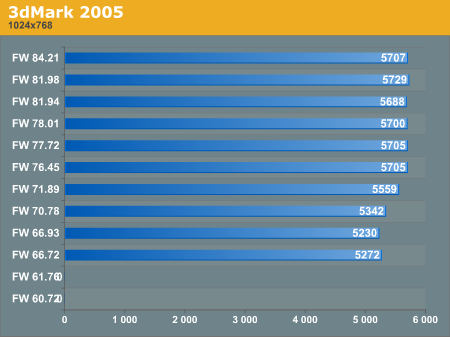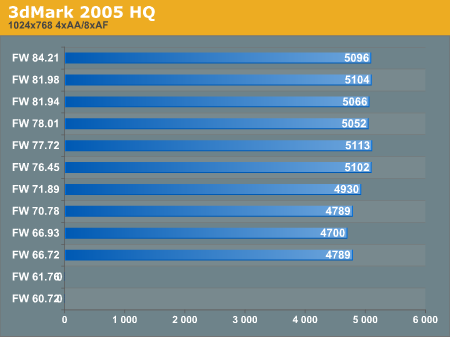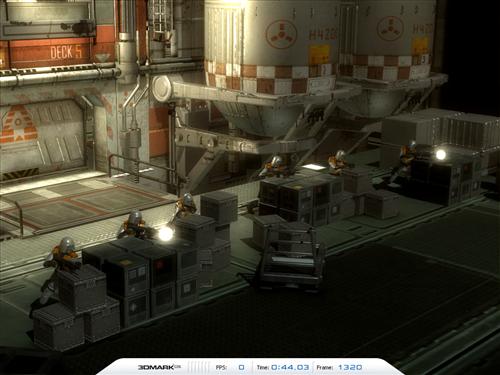Looking Back Pt. 3: The 6800 Ultra, ForceWare, and the Future
by Ryan Smith on May 11, 2006 4:00 AM EST- Posted in
- GPUs
3DMark05
As we continually note, 3DMark isn't something we normally use in an article due to its nature as a synthetic benchmark instead of being a real game. That said, it's an excellent diagnostic tool both for its wide customizability and the ability to render specific frames. However, it's also highly prone to being manipulated (both fairly and unfairly) due to the value some groups attach to it, so while it has little worth as a real-world gaming benchmark, it's a great indicator of just what kind of performance improvements a company can wring out of a video card when given the proper motivation.We should note that because of NVIDIA's unusual driver release mechanisms, only a handful of the drivers tested here are actually Futuremark approved, whereas nearly every Catalyst driver we have tested has been approved. We do not have any reason to believe NVIDIA has been cheating in these cases, however.


The 60.72 drivers once again created a problem for us with 3DMark05, as attempting to run the benchmark would simply reboot our testbed. At this point we have some significant concerns over the quality of launch drivers in particular, but that's for another article. The 61.76 drivers have also been dropped, due to 3DMark05 not offering the ability to use the SM3.0 profiles with these drivers, and as a result the score would not be comparable with the other drivers.
Past that, we're particularly surprised with the results, as NVIDIA does not appear to implement any significant performance optimizations for a 3DMark. As we've mentioned before, with 3DMark's synthetic nature, we'd rather see NVIDIA and other GPU manufacturers put engineering resources into improving game performance rather than benchmark performance, and we're glad to see that this is the case.

ForceWare 66.72 versus 84.21
Mouse over for 84.21
Image quality once again remains unchanged, which is a good thing to see given NVIDIA's history with 3DMark03.










24 Comments
View All Comments
Schugy - Thursday, May 11, 2006 - link
nVIDIA has done quite a good job with linux drivers. It's simple to run this script and start your favourite game afterwards. nVIDIA's reward will be that I`ll buy a GF7800GT for AGP when it comes out. I wonder why the last anandtech linux story is more than 10 months old.KickusAssius - Sunday, May 14, 2006 - link
I have owned the 9000, 9500 PRO and 9700 PRO and I just hate ATI's drivers. I had problems with at least half of the games I played. Gradually they fixed certain problems, but other problems were never resolved even after contacting ATI directly via email and I was not the only one.Prior to this, I owned a Geforce 256 and Geforce 4 MX and Nvidia's drivers were nothing spectacular, but they always worked.
Now, I have owned the 6800GT, and the 7800GTX and the drivers have been excellent for a long time now. The only problems I ever had were in CSS, but Nvidia fixed that problem relatively quickly. Also, I have never had a system crash as a result of Nvidia drivers, but several times this happened with my 9700 PRO, (still loved the card though especially when drivers got better). I think that now both sides have excellent drivers, though ATI's control panel is simply annoying.
johnsonx - Thursday, May 11, 2006 - link
The image for Doom3 with the 60.72 driver can't be right; in the text you say there are major rendering issues with th 60.72 driver, but both images (normal and 'moused-over') look fine to me; the image presented as the 60.72 image looks identical to the 61.76 image presented below it.ozzimark - Thursday, May 11, 2006 - link
the pictures are too small for me to really even see anythingjohnsonx - Thursday, May 11, 2006 - link
oh, nevermind, i see it nowJarredWalton - Thursday, May 11, 2006 - link
The rendering error isn't "major" -- that's why we kept the 60.72 results in the graph. You could certainly play the game with the 60.72 drivers and never realized there was a "problem". For anyone else trying to find the anomaly, look for the vertical lines right in the center of the screenshot.synque - Thursday, May 11, 2006 - link
I think the conclusion the article draws is completely meaningless. Nothing can be said about NVIDIA because they either failed to improve the drivers, or the drivers were close to "optimal" from the start.One could speculate that the ATI drivers weren't optimal because they could be improved. But even that'd be guessing, because the driver team most likely optimizes for popular games after they are released (which could lead to special optimizations).
So I know exactly as much as I knew before reading the article. Weird.
z3R0C00L - Thursday, May 11, 2006 - link
Umm not true,You forget that the x8x0 line are essentially built on an improved R300 design. They're not an all new part. This means ATi have gradually worked to improve there drivers. They were optimal to begin with since they're essentially the same driver SDK that reaches to the time of the 9700 Pro.
I have a feeling that if a 9800 Pro were tested you'd see the same improvements in non video card bottlenecked situations.
This proves that the Catalyst driver team is superior to the Forceware driver team. But most of us have known this since Catalyst 3.0. Heck even Microsoft has stated this as well as 3rd party driver analysts. ATi's card have less issues then nVIDIA cards and carry with them less issues not fixed from previous releases. There's a simple way of checking this.. read the Driver Release notes from both ATi and nVIDIA.. you'll notice FAR more unresolved issues with nVIDIA drivers then ATi drivers. Many of them major issues.
One thing nVIDIA is better at, and this is a fact, is supporting older hardware (GeForce2,3,4). ATi's 8500 support is lackluster at best. I can't remember the last time a driver release focused on fixing issues that still exist since Catalyst 3.0 on the 8500 series.
Redofrac - Thursday, May 11, 2006 - link
Since Catalyst 3.0? I'm going to have to disagree with that.From firsthand experience owning a 9700 Pro with the earlier catalysts, I have to say that they were crap. Having to try multiple releases of the driver to find one that was actually stable isn't quite what I'd use for the mark of a good driver team. Every once in a while they'd manage to get out a stable release, and I'd stick with that one until the next, lest random games start crashing on me or glitching.
I can't speak for ATI's current drivers, which I'll assume are much better (dealing with drivers for a 9700 somewhat turned me away from ATI) but I find it a bit hard to say that 3.0 drivers were stable with a straight face.
LoneWolf15 - Friday, May 12, 2006 - link
And I owned a Radeon 9700(non-pro) and had no problems at all; in fact, I'd daresay it's the best card I've ever owned in terms of performance/stability/longevity. But, one experience does not equal all.I'm not debating your experience, but what if you had a borderline power supply at the time, for example? That could easily cause some issues.
Neither of us is a representative example of how the Radeon 95xx/97xx cards worked by ourselves. By and large though, the enthusiast community had very few issues with this series of cards.